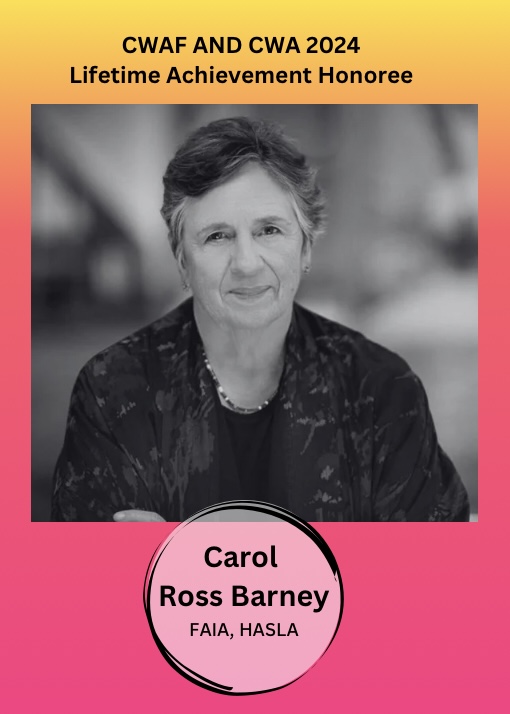Carol Ross Barney Recognized as
2024 Chicago Women in Architecture Lifetime Achievement Awardee

Carol Ross Barney, FAIA, HASLA
Established in 2017, the CWAF Lifetime Achievement Award honors distinguished architects who have profoundly impacted the profession, positively contributed as members of CWA, and have supported issues faced by women architects throughout their career. This year, the 2024 Lifetime Achievement Awardee is Carol Ross Barney, FAIA, HASLA.
Carol is the recipient of the 2023 American Institute of Architects Gold Medal. She is a renowned Architect for her expertise in civic space design and her dedication to creating exceptional public spaces. From small community facilities to prestigious academic and research buildings, as well as innovative transit stations and urban places and spaces, Carol’s work has left a lasting impact. Her designs have become cultural icons, showcasing her belief in the transformative power of the built environment on our daily lives.
As an architect, urbanist, mentor, and educator, she has relentlessly advocated that excellent design is a right, not a privilege. For nearly two decades, Carol’s studio has been working along Chicago’s Rivers, including design of the Chicago Riverwalk and a vision for improvements for all 150 miles of riverfront.
Among her notable projects are the Oklahoma City Federal Building, which replaced the Murrah Federal Building after a domestic terrorist attack, the CTA Cermak and Morgan Street Stations, McDonald’s Chicago and Disney World Flagship Restaurants, the Searle Visitor Center at the Lincoln Park Zoo, the JRC Synagogue in Evanston, the UMD Civil Engineering Building, the Multi-Modal Terminal at O’Hare International Airport, the NASA Aerospace Communications Facility, and Chicago’s new DuSable Park.
Carol’s exceptional work has garnered over 200 major design awards, including the prestigious Cooper Hewitt Smithsonian Design Museum National Design Award. She has also received fourteen National American Institute of Architects Honor Awards for Architecture, Interior Architecture, and Urban Planning and Design, as well as over 45 AIA Chicago Awards. Her commitment to sustainable design has been recognized with two AIA Committee on the Environment Top Ten Project Awards.
Carol is a graduate of the University of Illinois and has served as a U.S. Peace Corps volunteer in Costa Rica, where she contributed to national park planning. Additionally, she has been teaching an advanced Design Studio at the Illinois Institute of Technology for over thirty years, sharing her expertise and shaping the next generation of architects.
CAROL’S LETTER ON THE CWA:
In January, 1974, I saw a notice about a meeting of women architects because someone had posted it on our bulletin board at Holabird & Root. I went to this meeting. It was at Gert Kerbis’ office across the hall from Stanley Tigerman’s office. I sort of knew who he was at that point, I think. It was on Michigan Avenue above a hamburger chain called McConnell’s [O’Connell’s in AIC oral history] here in Chicago. Gert had only a one room office, and a lot of women showed up, probably more than a dozen. And I met these people for the first time.
I got there kind of early, and Gertrude was there. Gunduz Dagdelen was another person who was a really early advocate for CWA. We were all sitting around. And then Natalie de Blois came in; she swept in like a queen. I’m not kidding you. She had her own little entourage that she brought with her. The people in her entourage were Nancy Abshire and Margaret Young. And Natalie made a big entrance.
I remember that Gertrude and Natalie didn’t seem to like each other. And I learned later that they had been “frenemies” forever. They had really different outlooks on how to cope with being an architect in a big company. They had both worked for Skidmore. Natalie was a joiner, Natalie’s idea was, she wanted to do the work, she wanted to do the architecture.
In January 1974, the time was right and Chicago Women in Architecture turned out to be a dynamic group. They’re still in existence today, which is really remarkable when you think about it, that it’s going for that long.
At the first meeting we said we would get together again, we did. I bet all kinds of people that I didn’t know existed that were working in sort of tucked away places. There was Jane Jacobsen, who worked for the FAA. She was an architect, but she wasn’t doing architecture, but she was really interesting. Barbara Robinson [or Ralph?]. These women would be well over a hundred if they were alive now. They were sort of tucked away in places you never thought of finding them.
We decided to have an exhibit. So we made a formal organization called Chicago Women in Architecture. Because it was the seventies, we had a steering committee rather than a board. We had to be of the times. We didn’t have a president, because we didn’t need one. I mean, you know, that would have been a kind of “establishment” way to do things. We decided the first thing we were going to do is an exhibit of work by women architects. We made an alliance with a feminist gallery, Artemisia. It was on Hubbard Street right across from my office.
We did this first exhibit of women’s work in Chicago. We installed it ourselves. So this is when I got to be “important.” I was one of the few women working for a big architecture firm at that point. Natalie had just left Skidmore. I had resources and they knew it. And so they’d say, oh, “Carol, well, you have secretarial services” and you have all this, and you have all that, so you get it for us.” And I did. In fact, uh, the designer, the graphic designer for the “Contemporary Directions” exhibit, the Chicago Women Architecture Show, was the graphic designer at Holabird & Root. She did pro bono. And when we needed money to build it. I went into John Holabird one day, and I asked him, and he wrote a check on the spot.
So I became quite powerful, and they decided to make me president. We needed a president to make grant applications and stuff like that. The steering committee was not going over very well with the authorities. And so I became the first president. But it was mostly because I had a wealth of resources at that point, being with a big firm. I’m glad I didn’t miss that first meeting of CWA. I remember being impressed too. It was really impressive to me. I was 24 at the time. I was very impressed.
ABOUT THE AWARD
Established in 2017, the Chicago Women in Architecture Foundation Lifetime Achievement Award honors distinguished women who have positively contributed as a member of Chicago Women in Architecture and have supported issues faced by women architects throughout their careers. Award recipients are nominated and selected by CWA and CWAF as recognition of the awardee’s impact on the lives and careers of others in the architecture community, inspiring new generations of women to engage with CWA and the field of architecture. Previous awardees are Cynthia Weese, FAIA; Roula Alakiotou, FAIA; Linda Searl, FAIA; and Kathryn H. Anthony, PhD.
The awardee will be honored at the Opening Reception to our 50th Anniversary Exhibit at the CAC. DATE TBA.
ABOUT CWA AND CWAF
Chicago Women in Architecture (CWA)
CWA is a 501(c)(6) nonprofit membership organization founded in 1974 to establish community, mentorship, visibility, and advocacy for women working in the field of architecture and related professions. Through the ongoing efforts of the entirely volunteer-led organization, this mission is realized by offering educational, professional, and social networking events; organizing and sponsoring lectures in partnership with like-minded organizations; and awarding annual scholarships to women architecture students in their final year of study.
Chicago Women in Architecture Foundation (CWAF)
In 2003, CWAF was incorporated as a 501(c)(3) nonprofit. Today, CWAF continues its support of CWA initiatives by raising funds to expand scholarship offerings as well as fundraising for events and special projects that further the careers for women in and around the field of architecture.
